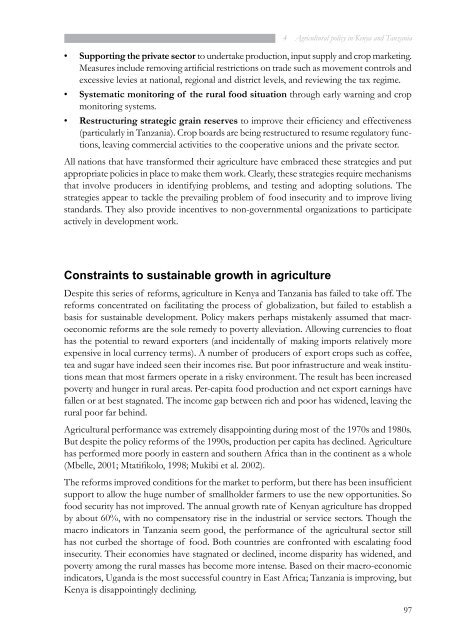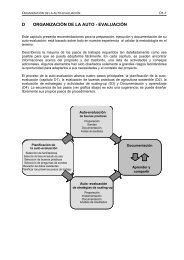cases from tanzania - Sustainet
cases from tanzania - Sustainet
cases from tanzania - Sustainet
You also want an ePaper? Increase the reach of your titles
YUMPU automatically turns print PDFs into web optimized ePapers that Google loves.
4 Agricultural policy in Kenya and Tanzania<br />
• Supporting the private sector to undertake production, input supply and crop marketing.<br />
Measures include removing artificial restrictions on trade such as movement controls and<br />
excessive levies at national, regional and district levels, and reviewing the tax regime.<br />
• Systematic monitoring of the rural food situation through early warning and crop<br />
monitoring systems.<br />
• Restructuring strategic grain reserves to improve their efficiency and effectiveness<br />
(particularly in Tanzania). Crop boards are being restructured to resume regulatory functions,<br />
leaving commercial activities to the cooperative unions and the private sector.<br />
All nations that have transformed their agriculture have embraced these strategies and put<br />
appropriate policies in place to make them work. Clearly, these strategies require mechanisms<br />
that involve producers in identifying problems, and testing and adopting solutions. The<br />
strategies appear to tackle the prevailing problem of food insecurity and to improve living<br />
standards. They also provide incentives to non-governmental organizations to participate<br />
actively in development work.<br />
constraints to sustainable growth in agriculture<br />
Despite this series of reforms, agriculture in Kenya and Tanzania has failed to take off. The<br />
reforms concentrated on facilitating the process of globalization, but failed to establish a<br />
basis for sustainable development. Policy makers perhaps mistakenly assumed that macroeconomic<br />
reforms are the sole remedy to poverty alleviation. Allowing currencies to float<br />
has the potential to reward exporters (and incidentally of making imports relatively more<br />
expensive in local currency terms). A number of producers of export crops such as coffee,<br />
tea and sugar have indeed seen their incomes rise. But poor infrastructure and weak institutions<br />
mean that most farmers operate in a risky environment. The result has been increased<br />
poverty and hunger in rural areas. Per-capita food production and net export earnings have<br />
fallen or at best stagnated. The income gap between rich and poor has widened, leaving the<br />
rural poor far behind.<br />
Agricultural performance was extremely disappointing during most of the 1970s and 1980s.<br />
But despite the policy reforms of the 1990s, production per capita has declined. Agriculture<br />
has performed more poorly in eastern and southern Africa than in the continent as a whole<br />
(Mbelle, 2001; Mtatifikolo, 1998; Mukibi et al. 2002).<br />
The reforms improved conditions for the market to perform, but there has been insufficient<br />
support to allow the huge number of smallholder farmers to use the new opportunities. So<br />
food security has not improved. The annual growth rate of Kenyan agriculture has dropped<br />
by about 60%, with no compensatory rise in the industrial or service sectors. Though the<br />
macro indicators in Tanzania seem good, the performance of the agricultural sector still<br />
has not curbed the shortage of food. Both countries are confronted with escalating food<br />
insecurity. Their economies have stagnated or declined, income disparity has widened, and<br />
poverty among the rural masses has become more intense. Based on their macro-economic<br />
indicators, Uganda is the most successful country in East Africa; Tanzania is improving, but<br />
Kenya is disappointingly declining.<br />
97




